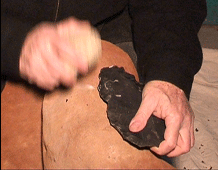Hand to Mouth

HANDTOMOUTH develops a framework for understanding archaeological and fossil evidence for the evolution of speech and manual dexterity. We focus on low-order parameters which can potentially be assessed in fossil and archaeological evidence. The focus will be on motor control in complex, serially ordered, goal-directed movements, with two sub-themes:
Speech production: This will involve physical and digital modelling of vocal tracts of extinct hominins based on anatomical parameters, to recover the range of articulatory manoeuvres and acoustic characteristics. As part of this there will be a comparative anatomical study of the human and nonhuman primate vocal tract and of the primate cranial nerves.
Tool use: This will address the relationship between action understanding and the self-generation of action sequences in human and non-human primates. It will include behavioural analysis of the action recognition system of nonhuman primates in sequentially complex action observation tasks, and kinematic analysis of movement control in stone tool-making and other tool-using tasks in healthy and apraxic human subjects.
Unifying framework: We intend to re-evaluate the possibility that speech may have evolved from an underlying substrate regulating socially-learned tool use, reflecting shared features of neural architecture. We will identify possible areas of convergence and/or homology in behavioural organization and in neural architecture in the two systems. HANDTOMOUTH will enable us to evaluate the extent to which their parallel evolution towards greater complexity in humans was necessary or contingent (and with a better understanding of the evidential controls).

 Prehistoric action grammar
Prehistoric action grammar  Diagnosing knapping skill
Diagnosing knapping skill  Understanding action recognition
Understanding action recognition  Action learning in macaques
Action learning in macaques  Neuroimaging of human tool use
Neuroimaging of human tool use  Vocal tract reconstructions
Vocal tract reconstructions  Neanderthal speech modelling
Neanderthal speech modelling  Primate cranial nerves
Primate cranial nerves